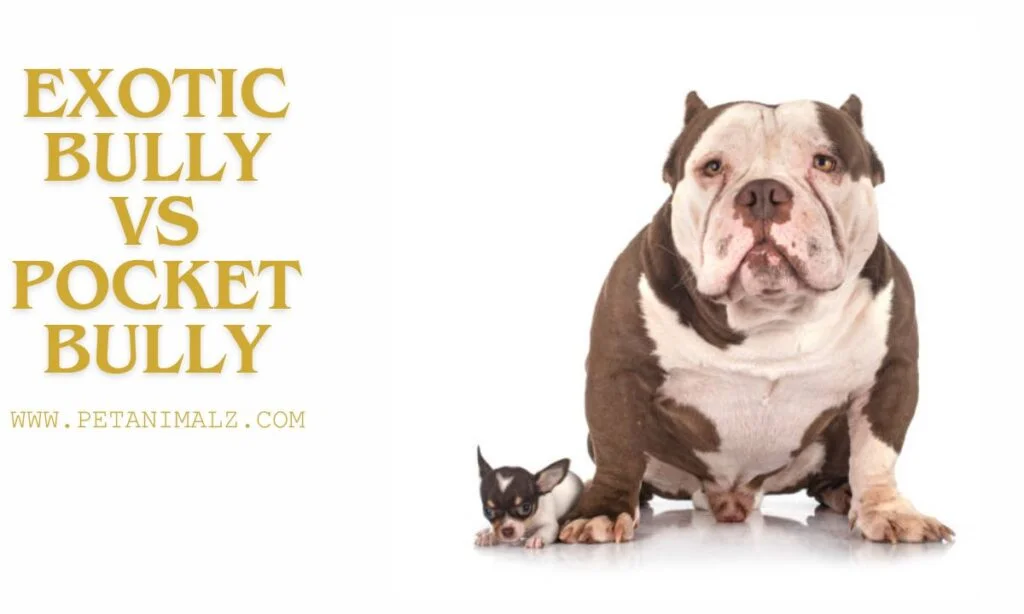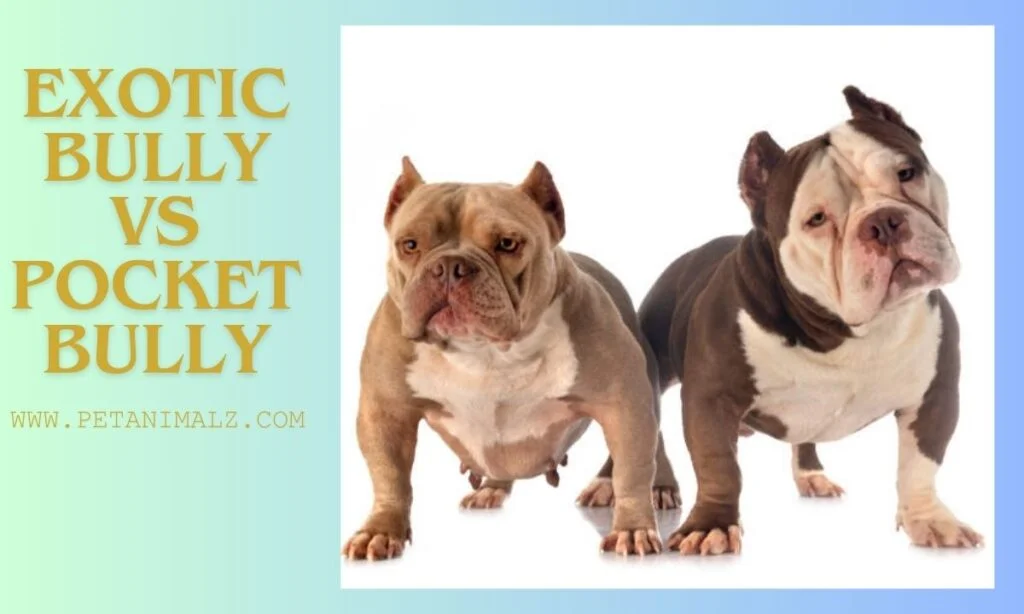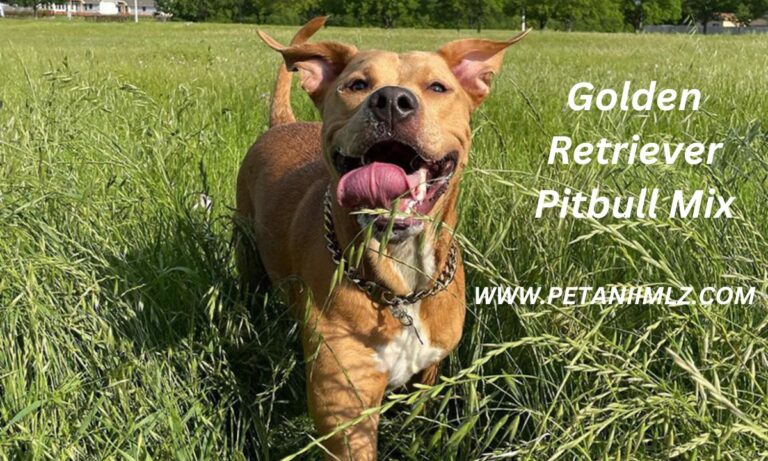Exotic Bully vs Pocket Bully: What’s The Difference

Introduction of Exotic Bully vs Pocket Bully
The Exotic Bully and the Pocket Bully are two amazing kinds of dogs that belong to the same species but differ in several ways. Exotic Bullying is greatly distinct from other types of bullies by its highly exaggerated characteristics. They are often little muscular dogs with thick bones and the prominent undershot type of jaws, large chests as well as very dense bodies. Their appearance is more radical, because of such traits as short faces or large heads that cause a more emphasized look.
Rather than temperament or function, they were bred mainly for their physical attractiveness by concentrating on these outlandish aspects. Conversely, Pocket Bully is a dwarf version of Standard American Bully, measuring between 14 to 17 inches high at shoulder level. Despite being smaller in size, they have a build that exhibits muscle and stockiness as would be expected from this kind of breed.
Pocket Bullies are affectionate dogs that get attached to their owners very easily; hence they make good companions. Their regular-looking body composition includes forward-holding postures together with well-formed shapes of the trunk; thus when it comes to appearances this breed appears powerful. This kind of dog is what people who appreciate the normal bully physical outlook but do not want too much body weight tend to choose.
Brief History of the American Bully
- The American Bully’s journey began in the 1980s, a blend of the American Pit Bull Terrier and the American Staffordshire Terrier. Over time, other breeds like the English Bulldog were introduced, leading to the unique Bully we know today.
- As the breed gained recognition, enthusiasts and breeders started to emphasize different traits. This led to the emergence of various types, each with its own set of characteristics. The Exotic Bully and Pocket Bully are just two of these fascinating offshoots.
Why the Confusion?
-
- With so many types of Bullies, it’s no wonder people often mix them up. Some think the names are just fancy terms for the same dog, while others believe they’re entirely different breeds.
- However, understanding the differences is crucial, especially for potential owners. Each type has its own needs, temperament, and health considerations. By distinguishing between the Exotic and Pocket Bully, one can ensure they’re making the right choice for their family and lifestyle.

POCKET BULLY VS EXOTIC BULLY: UNVEILING DIFFERENCES
The Exotic Bully and the Pocket Bully are two separate varieties of the American Bully breed, with individual characteristics that distinguish them.
“Exotic Bullies” are recognized for their physiognomy exaggerated features, which include a broader plusher structure as well as often having apparent shorter noses and squatty forms. They’re usually bred for their unusual look that may range from more pronounced to obviously “bulldog-ish” face style – they are generally smaller in size than other types of bullies and weigh everything from 30 to 50 pounds.
On the contrary, “Pocket Bullies” are smaller versions of standard American Bullies whose bodies remain stocky yet proportionate. Usually, they stand no more than 17 inches tall and this breed has a friendly disposition full of life with great loyalty.
Both breeds have strong muscular bodies but while Exotic Bullies come across as those with extreme features; Pocket Bullies highlight on balance in terms of body shape by being compact.
Exotic Bullies Are Smaller Than American Bullies
Yes, that’s generally true. The term “Exotic Bully” refers to a newer and still-evolving breed that is often characterized by its smaller size, unique physical features, and a more compact frame compared to the American Bully. The Exotic Bully is often sought after for its distinctive appearance, which includes a shorter stature, more pronounced facial features, and sometimes even a more “exaggerated” look.- On the other hand, the American Bully is a well-established breed that comes in several size categories, including pocket, standard, classic, and XL. While the pocket size might be comparable to or even smaller than some Exotic Bullies, the standard and larger sizes of American Bullies are generally bigger than Exotic Bullies.
- It’s important to note that the Exotic Bully is still a controversial breed among many dog enthusiasts and breeders. Some believe that the exaggerated features of the Exotic Bully can lead to health issues. As with any breed, potential owners should do thorough research and choose reputable breeders who prioritize the health and well-being of the dogs.
THE RISE OF EXOTIC BULLY DOG :
The upward push of the unusual bully dog breed has won full-size interest in current years. Known for his or her muscular construct, unique look, and constant temperament, exotic bullies have grow to be a popular choice for the dog fanatics. Originating from the American Bully, these dogs are selectively bred to emphasize specific features including a compact, stocky frame and exaggerated facial tendencies. Their recognition is fueled through social media and the growing fashion of owning rare, visually putting pets. However, the rise of this breed additionally increases concerns about ethical breeding practices, capacity health issues, and the want for accountable possession.
American Bullies Come in Various Sizes
Yes, that’s correct. The American Bully breed has been categorized into several size variations, each with its own set of standards. Here are the primary size categories for the American Bully:
- Pocket: This is the smallest size category. Despite the name, Pocket Bullies are not tiny dogs. They are compact but still muscular and robust. Males under this category are typically under 17 inches (but no less than 14 inches) at the withers, while females are under 16 inches (but no less than 13 inches).
- Standard: This category represents the baseline size for the American Bully. Males in the Standard class typically stand between 17 and 20 inches at the withers, while females stand between 16 and 19 inches.
- Classic: The Classic Bully retains the typical breed build but is less muscular and has a lighter body frame. Their size is similar to the Standard Bully.
- XL (Extra Large): As the name suggests, these are the largest American Bullies. Males typically stand over 20 inches (with some reaching up to 23 inches or more) at the withers, while females are usually over 19 inches.
- Extreme: This isn’t always recognized as a separate size category but rather a descriptor of the breed’s exaggerated features. Extreme Bullies might have more pronounced muscular development and bone structure.
It’s essential to note that while size is a distinguishing factor among these categories, other breed standards, such as temperament, appearance, and overall structure, remain consistent across the board. The American Bully is known for its friendly demeanor, loyalty, and confidence, regardless of its size.
Exotic Bullies Are Energetic But Not Very Athletic
That’s a fair characterization for many Exotic Bullies. Here’s a breakdown of that statement:
- Energetic: Like many breeds, Exotic Bullies can be lively and spirited, especially as puppies. They may have bursts of energy, enjoy playtime, and be quite active indoors.
- Not Very Athletic: The Exotic Bully’s physique is not built for prolonged physical exertion or high-intensity activities. Their compact frame, shorter legs, and often “smushed” facial structure (brachycephalic) can make it harder for them to engage in sustained athletic activities. Brachycephalic breeds can have breathing difficulties, especially in hot or humid conditions, so it’s essential to monitor them closely during physical activities.
It’s worth noting that individual dogs can vary. While the general breed characteristics might lean one way, individual Exotic Bullies might be more or less energetic or athletic than the average.
As always, if someone is considering adopting or purchasing an Exotic Bully, it’s crucial to understand the breed’s needs and potential health concerns. Regular check-ups with a veterinarian and understanding the specific needs of brachycephalic breeds can help ensure the dog’s health and well-being.
American Bullies Can Be More Energetic Than Exotic Bullies
Yes, in general, American Bullies can be more energetic than Exotic Bullies. Here’s a breakdown of this observation:
- Breed Origins and Purpose: The American Bully was developed from various breeds, including the American Pit Bull Terrier and the American Staffordshire Terrier. These breeds were originally working dogs with higher energy levels. The American Bully, while bred primarily as a companion dog, has retained some of this energy.
- Physical Structure: American Bullies, especially those in the standard and XL categories, have a more athletic build compared to the compact and often more “exaggerated” physique of the Exotic Bully. This athletic build can lend itself to more extended periods of activity.
- Health and Breathing: Exotic Bullies, with their more pronounced brachycephalic (short-nosed) features, can sometimes have more pronounced breathing difficulties compared to American Bullies. Breathing issues can limit the amount of physical activity an Exotic Bully can comfortably engage in, especially in hot or humid conditions.
- Individual Variation: It’s essential to remember that energy levels can vary widely within any breed. Some American Bullies might be more laid-back, while some Exotic Bullies might be particularly lively.
- Training and Socialization: Both breeds benefit from early training and socialization. An adequately trained and socialized dog, regardless of breed, is more likely to channel its energy in positive ways and be more manageable overall.
Exotic Bullies Are Prone to Weight Gain
Yes, Exotic Bullies, like many short and stocky breeds, can be prone to weight gain. Here are some reasons and considerations regarding this tendency:
- Physique: Their compact and muscular build can sometimes give the illusion of being healthy, even if they are carrying extra weight. It’s essential to be aware of their ideal weight range and monitor it regularly.
- Activity Level: While Exotic Bullies can be energetic in short bursts, they are not typically as active as some other breeds. Their lower activity level, combined with their physical structure, can make them more susceptible to gaining weight.
- Diet: Overfeeding or providing a diet that’s not well-suited to their needs can quickly lead to weight gain. It’s crucial to feed them a balanced diet appropriate for their age, size, and activity level.
- Health Implications: Excess weight can exacerbate potential health issues common in the breed, such as joint problems or breathing difficulties due to their brachycephalic nature.
- Regular Check-ups: Regular vet check-ups can help monitor their weight and overall health. A veterinarian can provide guidance on the ideal weight for an individual dog and offer dietary and exercise recommendations.
- Exercise: While they might not be the most athletic breed, regular exercise is essential. Short walks, play sessions, and other activities can help keep them fit and mentally stimulated.
- Treats: It’s essential to be mindful of the number and type of treats given. Treats should be factored into their daily caloric intake, and it’s always a good idea to opt for healthier treat options.
Exotic Bully vs Pocket Bully Physical Characteristics:
Exotic Bully
- Size, Weight, and General Appearance: The Exotic Bully stands shorter than most Bullies, often between 10 to 12 inches. They possess a robust and muscular build, weighing anywhere from 30 to 40 pounds.
- Unique Features: What sets them apart is their more pronounced bulldog-like appearance. They have a broader head, shorter legs, and a more compact body, giving them a distinct look.
Pocket Bully
- Size, Weight, and General Appearance: The Pocket Bully is a bit taller, ranging from 12 to 16 inches. They typically weigh between 35 to 50 pounds, showcasing a well-defined musculature.
- Distinctive Traits: Compared to the Exotic, Pocket Bullies have a more balanced proportion. They don’t have the extremely shortened limbs of the Exotic and often appear more athletic.
Temperament and Behavior
Exotic Bully
- General Behavior and Personality Traits: Exotic Bullies are known for their affectionate nature. They’re calm, loyal, and often quite playful.
- Interaction with Families and Other Pets: They gel well with families, especially with children. However, early socialization is key if they’re to coexist peacefully with other pets.
Pocket Bully
- General Behavior and Personality Traits: Pocket Bullies are energetic, intelligent, and incredibly loyal. They thrive on human interaction and are always eager to please.
- Family Settings: They’re excellent family dogs, protective of their loved ones, and generally good with children, making them a favorite choice for many households.
Health and Lifespan
Exotic Bully
- Common Health Issues: Due to their unique structure, they can face issues like hip dysplasia, respiratory problems, and joint issues.
- Average Lifespan and Care Tips: They live around 8-12 years. Regular vet check-ups, a balanced diet, and moderate exercise can help mitigate some health risks
Pocket Bully
- Common Health Issues: They’re prone to similar health concerns, with hip dysplasia being a common ailment.
- Average Lifespan and Care Tips: Their lifespan ranges from 9-13 years. Regular exercise, a nutritious diet, and routine vet visits are essential for their well-being.
Care and Maintenance
Exotic Bully
- Dietary Needs: High-quality dog food, preferably with a good protein source, is ideal. Avoid overfeeding to prevent obesity.
- Exercise Requirements: Moderate exercise, like short walks and play sessions, is sufficient.
- Grooming: Their short coat requires minimal grooming. Regular brushing and occasional baths will do.
Pocket Bully
- Dietary Needs: They require a protein-rich diet to maintain their muscle mass. Portion control is crucial.
- Exercise Requirements: They’re more energetic and benefit from regular walks and playtime.
- Grooming: Similar to the Exotic, their short coat is low maintenance. Weekly brushing is recommended.
Frequently Asked Questions
What is the average price for an Exotic/Pocket Bully?
Both breeds can range from $2000 to $5000, depending on lineage and breeder reputation.
Are these breeds suitable for families with children?
Absolutely! Both breeds are affectionate and protective, making them great family pets.
What’s the difference between Pocket Bully and Exotic Bully?
Pocket Bully: This is a smaller version of the American Bully dog. It stands between 12 to 16 inches tall. They have a compact, muscular body and a balanced proportion.
Exotic Bully: This breed is known for its unique physical features, often having shorter legs, a broader head, and a more compact body than other bully breeds. They often display more pronounced bulldog-like features.
What is the best breed of Bully?
“Best” is subjective and depends on what an individual is looking for. Each bully breed has its own set of characteristics, temperament, and care needs. For families, the American Bully is often recommended due to its friendly and protective nature.
What is an Exotic Pocket Bully?
An Exotic Pocket Bully is essentially a blend of the two types mentioned above. It’s a smaller-sized bully (like the Pocket Bully) but with the distinctive physical features of the Exotic Bully.
Is Micro Bully Exotic?
Not necessarily. The term “Micro Bully” refers to the size, indicating it’s even smaller than the Pocket Bully. While a Micro Bully can have exotic features, it’s not a given. The “exotic” in Exotic Bully primarily refers to unique physical characteristics, not size.
What 2 breeds make a Pocket Bully?
The Pocket Bully is a descendant of the American Pit Bull Terrier and the American Staffordshire Terrier, with some influence from other breeds like the English Bulldog.
Conclusion:
In the end, we concluded that pocket bullying and exotic bullying are two separate varieties of the American bully breed. For instance, people who want unique and stylish appearances usually buy the Exotic Bully due to its extreme physical characteristics which may lead to health problems at times. On the other hand, those looking for loyal friends will always choose pocket bullies because they are medium-sized with well-built muscles at every part of their bodies. Eventually, it all boils down to individual tastes and way of life as each one has his or her preferred type that adds to the variety of American Bullies Additionally, which one is best will depend on your lifestyle and preferences.




